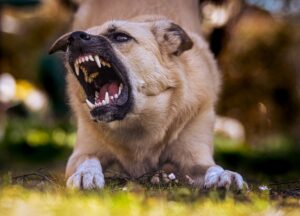Help! My dog wants to kill every dog it sees.
By Nancy Milburn
Dog on dog aggression is something every dog owner dreads. How embarrassing to have your dog lunging and barking at the end of a leash. If you have a large dog then there is a real danger of being dragged down the street.
{start article}
Help! My Dog Wants to Eat Every Dog it Sees
As a dog owner, you may be familiar with the feeling of helplessness when your furry friend goes wild at the sight of another dog. The barking, growling, and pulling on the leash can be embarrassing and frustrating, not to mention potentially dangerous for other dogs and their owners. So what can you do when your dog wants to eat every dog it sees? In this article, we will provide some helpful tips and advice to help you manage and overcome this challenging behavior.
Understanding the Root Cause of Aggression
The first step in addressing your dog’s aggression towards other dogs is to understand the underlying cause. Aggression in dogs can be triggered by a range of factors, including fear, territorial-ism, lack of socialization, and genetics. In some cases, the aggression may be related to an underlying medical condition, such as pain or hormonal imbalances.
It is essential to identify the root cause of your dog’s aggression to develop an effective management and training plan. A professional dog behaviorist or trainer can help you evaluate your dog’s behavior and develop an individualized plan to address the underlying cause of the aggression.
Training and Socialization
Training and socialization are critical components of managing aggression in dogs. Socializing your dog with other dogs from an early age can help prevent aggression by teaching your dog appropriate social behaviors and reducing fear and anxiety.
Training your dog to respond to commands, such as “sit” and “stay,” can also help you manage your dog’s behavior when encountering other dogs. Using positive reinforcement techniques, such as treats and praise, can help reinforce positive behaviors and reduce aggression.
It is essential to be patient and consistent when training your dog. Consistent training and positive reinforcement can help build a strong bond between you and your dog and establish a foundation for good behavior.
Physical and Mental Stimulation
Providing your dog with regular physical and mental stimulation can also help reduce aggression and prevent boredom. Dogs that are bored or under-stimulated are more likely to exhibit destructive behavior and aggression.
Providing your dog with regular exercise, such as walks, runs, or playtime, can help burn off excess energy and reduce stress and anxiety. Mental stimulation, such as puzzle toys or training exercises, can also help keep your dog engaged and mentally stimulated.
It is important to note that not all dogs require the same level of physical and mental stimulation. Some breeds, such as Border Collies or Australian Shepherds, require more exercise and mental stimulation than others.
Managing Aggressive Behavior
In some cases, despite your best efforts, your dog may continue to exhibit aggressive behavior towards other dogs. In these situations, it is essential to manage your dog’s behavior to prevent harm to other dogs and their owners.
It is important to remember that managing your dog’s behavior is not a substitute for training and addressing the underlying cause of the aggression. Professional dog trainers and behaviorists can help you develop an individualized plan to address your dog’s aggressive behavior and prevent future incidents
.Aggressive behavior in dogs can be a challenging and potentially dangerous issue for dog owners. However, with patience, consistency, and professional guidance, it is possible to manage and overcome this behavior. By understanding the root cause of your dog’s aggression, providing proper training and socialization, and managing aggressive behavior when necessary, you can help your dog become a well-behaved and happy companion.
